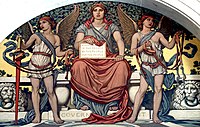
Photo from wikipedia
This paper examines the impact of the European Central Bank’s unconventional monetary policy (UMP) on bank lending supply and performance in the euro area, through comparing the evolution of bank-specific… Click to show full abstract
This paper examines the impact of the European Central Bank’s unconventional monetary policy (UMP) on bank lending supply and performance in the euro area, through comparing the evolution of bank-specific variables before and after the UMP implementation. By using a dynamic panel data analysis on banks across discrete country groups (euro zone, core, peripheral) and by controlling for bank-specific and country-level variables, we provide evidence that the bank lending decisions and performance of euro zone banks are not UMP driven, implying the limited ability of the ECB to enhance the effectiveness of banks’ lending channel and to affect banks’ profitability during the crisis. Our findings also suggest that different criteria determine banks’ lending strategy before the UMP period, bank credit strategies vary across the country samples, while the weaker economies’ banks seem to underestimate the impact of liquidity risk on their lending activity.
Journal Title: Journal of Economics and Finance
Year Published: 2019
Link to full text (if available)
Share on Social Media: Sign Up to like & get
recommendations!